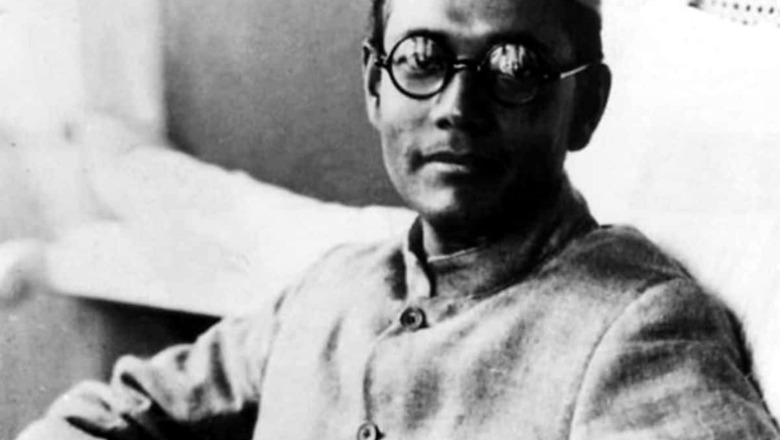
views
The fight over the legacy of Netaji, which, is more than obvious, has been propelled by the gains to be made in the upcoming assembly polls in West Bengal, has inadvertently come to affect a part of history integral to his heritage that has largely gone unnoticed.
The Bharatiya Janata Party (BJP) is celebrating the upcoming 125th birth anniversary of charismatic freedom fighter Netaji Subhas Chandra Bose as Parakram Diwas on Saturday, and railway minister Piyush Goyal has contributed his bit by renaming the more than 150-years-old Howrah-Kalka Mail as Netaji Express.
In a recent post on microblogging site Twitter, Goyal wrote, “Netaji’s parakram (valour) put India on the express route of freedom and development. I am thrilled to celebrate his birth anniversary with the introduction of Netaji Express.” The tweet, however, did not mention the Kalka Mail.
Run by the East Indian Railway Company, the train began operations between Calcutta (now Kolkata), then capital of British India, and Delhi in 1866 as the East Indian Railway Mail and was extended from Delhi to Kalka, in the Shimla foothills, in 1891, after a rail link was built from Ambala to Kalka.
In 1864, Shimla was declared as the summer capital of British India. The train became the crucial cog in the machinery which moved the British officialdom from Calcutta, the permanent capital, to Shimla during the summer months. At the Howrah railway station in Kolkata, there still exists the carriageway which ferried the Viceroy and other senior officials right up to the coach. At Allahabad (now Prayagraj), the train coaches were ferried across the Ganga on boats.
From Kalka to Shimla, the journey was undertaken on a metre-gauge rail track winding through the beautiful mountain route. This heritage rail track, opened on November 7, 1903, with 102 tunnels dotting the 96-kilometre stretch, still exists. The premier status of the train could be discerned from the fact that it was numbered as 1 Up for the journey from Kolkata to Kalka and 2 Dn from Kalka to Kolkata.
However, with the rationalisation of train numbering in the 1990s, the Kalka Mail lost its 1 Up/2 Dn numbering and is now the 12311 from Howrah and the 12312 from Kalka. After this, 12311 and 12312 would be known as Netaji Express.
Soon after the launch of the railways in India in the second half of the 19th century and till the gaining of freedom in 1947, mid-20th century, and even later, the mail trains played a significant role in connecting various parts of the subcontinent by not just carrying passengers but also official communications and other logistics. Trains like Kalka Mail, Punjab Mail, Frontier Mail and Madras Mail remain essential to modern Indian history.
The legacy of Kalka Mail is integral to the famed Bengali culture and folklore. Doyen of modern Indian cinema Satyajit Ray gave Kalka Mail an iconic status through the plot of his famous story Baksho Rahasya of the detective Feluda series, where the protagonists travel by Kalka Mail from Kolkata to Shimla. Later, it was adapted into a radio play with legendary Soumitra Chatterjee playing Feluda and a telefilm in the 1990s by Ray’s son Sandip with Sabyasachi Chakrabarty playing the detective.
Now coming to Netaji’s connection with Kalka Mail, which must have justified the renaming of the hoary locomotive to Netaji Express. Kalka Mail is not the first railway property to be named after Netaji. The Gomoh station in the coalfields of Jharkhand was renamed Netaji Subhas Chandra Bose Gomoh station in 2009.
Following the outbreak of World War II in 1939, Bose was arrested and put in jail, from where he was released following a seven-day hunger strike. However, he was kept under surveillance at his Elgin Road residence in Calcutta, from where he planned his escape in 1941. Days before his ‘breakout’, Netaji went into solitude and grew a beard.
On the night of January 17, 1941, Bose escaped from Calcutta in a car in the garb of a Pathan and came to Barari Coke Plant in Jharia Coalfield (Jharkhand), where his nephew Sisir Bose, was employed as a chemical engineer. From Barari, he left for Gomoh, which was a busy railhead of the coalfields on the Grand Chord Line connecting Delhi with Kolkata.
From Gomoh, he took the Kalka Mail and then boarded 63Up Howrah-Peshawar Express, for the long journey, known as Mahanishkraman. From Peshawar, he went to Afghanistan, the Soviet Union, Germany, Japan, and finally led the Indian National Army in the battle with the British forces on the Burma border.
Barari Coalfield is today a tourist spot commemorating Netaji’s great escape which had left the mighty British Empire red faced. There has also been a long demand of the Forward Bloc, the political party founded by Netaji, to rename Gomoh town as Netaji Nagar.
(The writer is a senior journalist and political analyst. Views expressed are personal.)
Read all the Latest News, Breaking News and Coronavirus News here




















Comments
0 comment